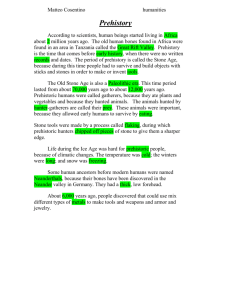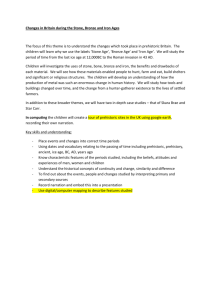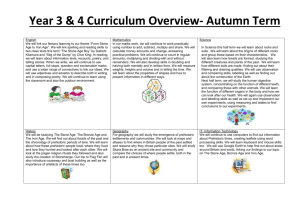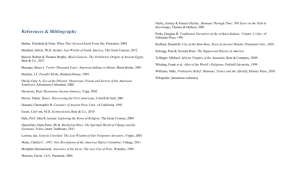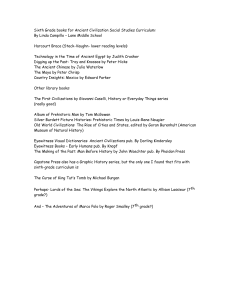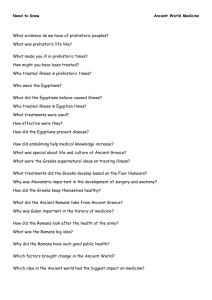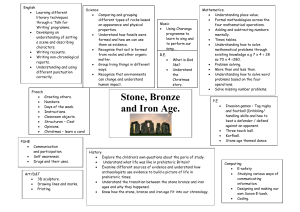The Art of Ancient Technology - nau.edu
advertisement
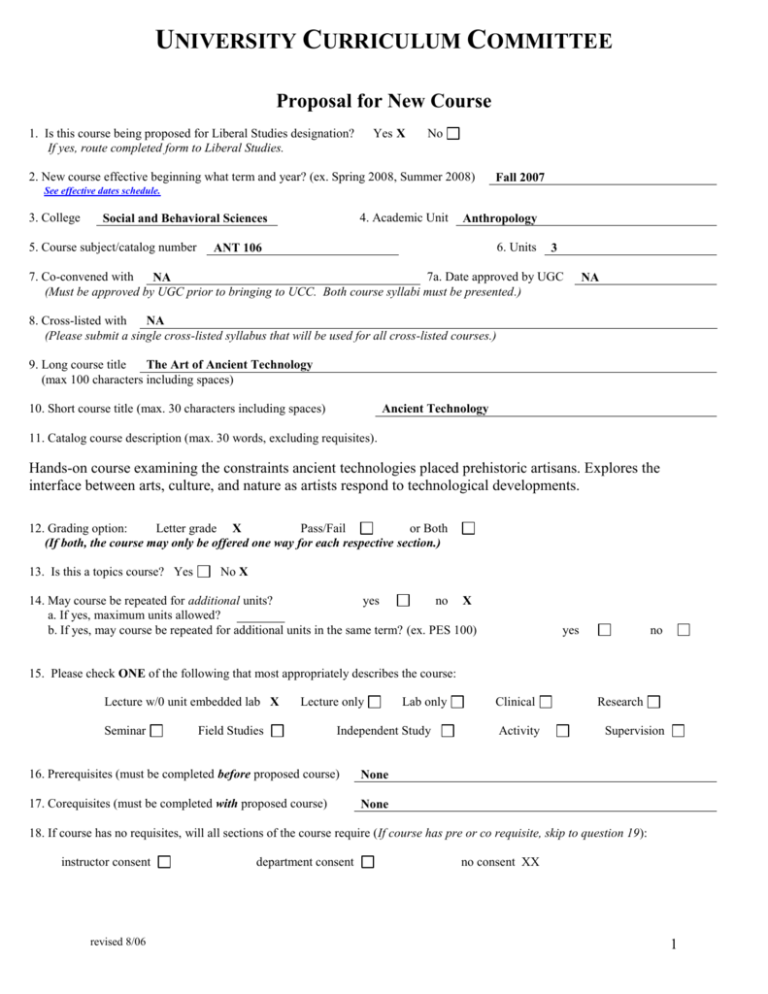
UNIVERSITY CURRICULUM COMMITTEE Proposal for New Course 1. Is this course being proposed for Liberal Studies designation? If yes, route completed form to Liberal Studies. Yes X No 2. New course effective beginning what term and year? (ex. Spring 2008, Summer 2008) Fall 2007 See effective dates schedule. 3. College 4. Academic Unit Social and Behavioral Sciences 5. Course subject/catalog number Anthropology 6. Units ANT 106 3 7. Co-convened with 7a. Date approved by UGC NA (Must be approved by UGC prior to bringing to UCC. Both course syllabi must be presented.) NA 8. Cross-listed with NA (Please submit a single cross-listed syllabus that will be used for all cross-listed courses.) 9. Long course title The Art of Ancient Technology (max 100 characters including spaces) 10. Short course title (max. 30 characters including spaces) Ancient Technology 11. Catalog course description (max. 30 words, excluding requisites). Hands-on course examining the constraints ancient technologies placed prehistoric artisans. Explores the interface between arts, culture, and nature as artists respond to technological developments. 12. Grading option: Letter grade X Pass/Fail or Both (If both, the course may only be offered one way for each respective section.) 13. Is this a topics course? Yes No X 14. May course be repeated for additional units? yes no X a. If yes, maximum units allowed? b. If yes, may course be repeated for additional units in the same term? (ex. PES 100) yes no 15. Please check ONE of the following that most appropriately describes the course: Lecture w/0 unit embedded lab X Seminar Lecture only Field Studies Lab only Independent Study 16. Prerequisites (must be completed before proposed course) None 17. Corequisites (must be completed with proposed course) None Clinical Activity Research Supervision 18. If course has no requisites, will all sections of the course require (If course has pre or co requisite, skip to question 19): instructor consent revised 8/06 department consent no consent XX 1 19. Is the course needed for a plan of study (major, minor, certificate)? yes Name of new plan? Note: A new plan or plan change form must be submitted with this request. no X 20. Does course duplicate content of existing courses within or outside of your college? yes no X If yes, list any courses this course may have duplicative material with and estimate percentage of duplication: Please attach letters of support from each department whose course is listed above. 21. Will this course affect other academic plans, academic units, or enrollment? yes If yes, explain in justification and provide supporting documentation from the affected departments. 22. Is a potential equivalent course offered at a community college (lower division only)? If yes, does it require listing in the Course Equivalency Guide? yes Please list, if known, the institution, subject/catalog number of the course. yes no no X X no 23. Justification for new course, including unique features if applicable. (Attach proposed syllabus in the approved university format). Students explore the linkage between artistic expression and prehistoric technology through handson exercises involving prehistoric raw materials, tools, and the end products of prehistoric art and technology. The course gives students the chance to experience the techniques and to understand the deep symbolic and aesthetic elements of nearly two million years of technological development. Our prehistoric ancestors approached their daily tasks with a range of ingenious and culturally aesthetic technologies. Nearly all examples of prehistoric tools and devices contained an aesthetic and symbolic component that we rarely see and almost never appreciate today. Students learn that prehistoric technologies hold important keys for understanding our past and for envisioning the future. (Please see proposed syllabus). 24. Names of current faculty qualified to teach this course Dr. Francis Smiley, Dr. Andrea Hunter; Dr. Christian Downum, Dr. Kelley Hays-Gilpin 25. If course will require additional faculty, space, or equipment, how will these requirements be satisfied? NA 26. Will present library holdings support this course? yes revised 8/06 X no 2 If the course being submitted for approval is NOT a LIBERAL STUDIES course, please go to step 42. LIBERAL STUDIES ONLY Contact name: Francis Smiley Contact email: francis.smiley@nau.edu Dept. Chair name: George Gumerman Dept. Chair email: george.gumerman@nau.edu College Contact name : Larry Gould College Contact email: larry.gould@nau.edu 27. This course is a Multi-section XX Single section 28. List names of faculty who may teach this course: Chris Downum; Andrea Hunter; Kelley Hays-Gilpin; Francis Smiley 29. Section enrollment cap: 35 If this course is being submitted for approval as a new LIBERAL STUDIES course, please complete questions 30-33. OR If this course is being submitted for approval as a new JUNIOR LEVEL WRITING course, please complete questions 37-38. OR If this course is being submitted for approval as a new SENIOR CAPSTONE course, please complete questions 39-41. NEW LIBERAL STUDIES COURSE 30. Thematic Focus (check all that apply): If a topics course, must apply to ALL sections. Environmental Consciousness Technology and Its Impact XX Valuing the Diversity of Human Experience XX 31. Distribution Block (check one): If a topics course, must apply to ALL sections. Aesthetic and Humanistic Inquiry XX Science/Applied Science Cultural Understanding Lab Science Social and Political Worlds 32. Skills (check two): If a topics course, must apply to ALL sections. Creative Thinking XX Critical Reading Effective Oral Communication Effective Writing Critical Thinking Ethical Reasoning Quantitative/Spatial Analysis XX Scientific Inquiry XX Use of Technology XX 33. Is this a topics course? Yes No XX If YES, please complete questions 34-36. If NO, please go to question 42. TOPICS COURSE ONLY 34. Identify the Student Learning Outcomes that will be found in ALL topic syllabi offered under this course number. 35. Explain by what method(s) Student Learning Outcomes will be assessed in ALL topic syllabi offered under this course number. 36. Please attach an example of a Topic Syllabus offered under this course number. GO TO question revised42 8/06 3 NEW JUNIOR LEVEL WRITING COURSE (refer to question 19) 37. To which degree programs offered by your department/academic unit does this proposal apply? 38. Do you intend to offer ABC 300 and ABC 300W? yes If no, please submit a course delete form for the ABC 300. no GO TO question 42 NEW SENIOR CAPSTONE COURSE (refer to question 19) 39. To which degree programs offered by your department/academic unit does this proposal apply? 40. Does this proposal replace or modify an existing course or experience? yes If yes, which course(s)? no 41. Do you intend to offer ABC 400 and ABC 400C? yes no If no, please submit a course delete form for the ABC 400. 42. Approvals Department Chair (if appropriate) Date Chair of college curriculum committee Date Dean of college Date For Committees use only For Liberal Studies Committee Date Action taken: _____________________ Approved as submitted For University Curriculum Committee ___________________________ Approved as modified Date Action taken: Approved as submitted revised 8/06 Approved as modified 4 1 Proposed New Course Syllabus ANT 106 – The Art of Ancient Technology College & Department: Social and Behavioral Sciences; Department of Anthropology Course Prefix, Number, & Title: ANT 106 The Art of Ancient Technology Semester Course will be offered: Fall 2007 Credit Hours: 3 Instructor’s Name: Francis E. Smiley Office: Room 109, Bldg. 98D Office Hours: Four hrs/week – To be determined Course Prerequisites: None Course Description: Students explore the linkage between human artistic expression and the limits of prehistoric technology through a series of hands-on experiments in prehistoric technology and artistic design. Student Learning Expectations/Outcomes for this Course By the end of the course, students will: • understand the development of the prehistoric relationship between aesthetics and technological development • understand the inherent limitations that raw materials and production technologies place on the resulting aesthetic creations • know the variety of ways in which people select, evaluate, and use materials from the environment that they transform into cultural objects • know the trajectory of development from stone and fiber technologies to ceramic production. • be able to appreciate the different perspectives that archaeologists, art historians, and material scientists take in examining ancient technology. Course Structure/Approach: The course employs illustrated lectures on the web, web-based computer simulations, and weekly exercises to provide an intimate view of and experience in working with ancient technologies from the perspective of technology as artistic human expression. This course will help students develop an understanding of the relationship between technical context and human creative expression. revised 8/06 5 2 Taking the perspective of the ancient craftsperson, archaeologist, art historian, and material scientist the course focuses on the inherent limitations of production technologies and the resulting aesthetic creations. Students will also develop their capacities for analysis and reasoning along with an understanding of the multiple facets of the human condition as expressed through the artistry of their so called “primitive” tools and architecture. People today are often astounded at the artistic, technological, and architectural achievements of ancient cultures. The course examines the trajectory of human experience and values, as expressed through creative endeavors, from the first appearance of modern humans and their art and technology up to the historic era (ca.. 2000 B.P.). Text: Prehistoric Art: The Symbolic Journey of Humankind by Randall White Selected Online Readings on prehistoric technology Course Outline: Weekly Modules and Lecture Topics 1. Art as Tech and Tech as Art. Technology consists of three elements: the raw materials used, the tools used to work the materials, and the final product. People living in the 21 century tend st to think that societies choose materials like metals, ceramics, and fibers because of specific physical qualities or because of their performance under a given set of conditions of use. However, the choice of materials and the development of specific properties often result from ideological and aesthetic criteria and are chosen because of social and cultural values. In fact, it is the aesthetic use of a raw material and experimentation within the cultural values that can lead to technological innovation. The course pays particular attention to the relations among ideology, values, and technological development. Topic 1: Introduction to the Union of Tech and Expression. Topic 2: Technology Dictates the Ranges of Possibility for Artistic Expression. Topic 3: The Engine for Technological Development. 2. The Art of Technology as a Window on the Human Career. Two million years of human prehistory teach us that innovation in aesthetic expression and technology reveal the inflection points in our long, remarkable developmental process. The inflection points mark the evolution of the quintessential human attributes of self-awareness, modern human cognition, and the drive to express emotion, spirituality, and identity in material form. The module sets out the structure and subject matter for the remainder of the semester by outlining for students the rise of the material arts during the past 40,000 years. Topic 4: Earliest Human Technology Two Million -100,000 BP – Is It Art? Topic 5: The Middle Paleolithic Art and Technology: The First Inklings Topic 6: The Upper Paleolithic Art and Technology: Art Explodes Topic 7: Art and Technology Neolithic Art and Technology revised 8/06 6 3 3. The Rise of Reductive Art and Craft: Chipping Away the Debris. The earliest human manufactures and expressions are nearly entirely reductive in nature: we begin with some raw material and we remove from it everything that is not what we want. We finish with a reduced piece shaped and finished to our aesthetic and functional needs. So begins the human career in art and craft. The module introduces the process and possibilities of stone working, or flintknapping, as archaeologists know it. Of all the manufacturing techniques invented through the ages, flintknapping is easily the least intuitive, the most dangerous, and arguably the most aesthetically satisfying of arts and crafts. Students learn the mechanics of achieving art in lithic process – a difficult kind of game in which the flintknapper plays chess with physics in stone. Topic 8: The Techniques of Core Tool Reduction Topic 9: The Techniques of Blade Tools and Blade Cores Topic 10: The Techniques of Bifacial Reduction 3. The Aesthetics of Stone: Flintworking -- the Most Permanent Art. We have worked in stone for more than two million years. Compared to our modern rate of technological and aesthetic innovation, the excruciatingly slow evolution of stone technology stands as a mystery explored for over 100 years by archaeologists. The arts of ancient flintknappers around that world are often so difficult to understand and emulate that only in the past few decades have archaeologists expert in stone technology begun to master some of the esoteric techniques that have produced examples of world-class art in chipped stone. Topic 11: Lithic Style as Spatial and Diachronic Art Topic 12: Folsom and Clovis – Technology That Can Only Be Art Topic 13: Maya Eccentrics: As Far As Flint Can Go 4. Scale and Stone Sculpture: Monumental and Miniature Carving in Stone. As early as the Middle Paleolithic our ancestors carved and scribed upon stones the phases of the moon, symbolic representations of religion and ethnic and social identity. We began to recognize the value of expression in the permanent medium of stone and the art of stone expression has evolved from simple, mobilary art objects to the stone friezes on the walls of buried temples in the jungles and deserts of the world. Topic 14: Sculpture in Miniature – Paleolithic Notation or Art? Topic 15: Sculpture in Prehistory – A Range of Media 5. Pottery: The Aesthetic Empress of Additive Technologies. Ceramic technology is additive technology – the potter begins with nothing and builds whatever he or she wants within the limits of the materials. Pottery technology becomes the pre-eminent prehistoric aesthetic medium. Topic 16: The Basis of Ceramic Technology Topic 17: Building Forms and Technologies Topic 18: Firing, Glazes, and Decoration Technologies 6. Pottery II: Art in Ethnic, Social, and Economic Communication. Art is all about communication – person to person, family to family and society to society ... ceramic technology evolves as the most expressive, widespread, communications medium in prehistory ... revised 8/06 7 4 Topic 19: Prehistoric Ceramics as Communication Topic 20: Pottery and Trade – Art Across Boundaries Topic 21: The Function of Ceramic Style Topic 22: Technology of the World’s Most Beautiful Prehistoric Ceramics 7. Midterm Examination: Comprehensive review of course material and an essay and short answer examination. 8. Painting: Technology of the Ancient Masters. Practiced on all continents and beginning about 40,000 years ago, paintings give aesthetic voice to peoples seeking to record historic events, ceremonial practice, and territorial dominance. Topic 23: Nowhere to Go But Down: The Artistic Explosion in Upper Paleolithic Cave Painting Topic 24: Petroglyph Styles in North America Topic 25: The Remarkable Rock Art of Aboriginal Australia 9. Basketry: The Arts and Aesthetics of Containers. Basketry unleashes the aesthetic potential of container technology for the first time. Previous containers are naturally occurring items like gourds or unwieldy manufactured items like heavy stone bowls. Baskets, as an additive and light-weight technology give wings to ancient peoples who need storage containers for utilitarian functions, but who quickly develop the utilitarian into a wide range of aesthetic expression. Topic 26: Early Basketry Impressions: Literally ... Marks in Clay. Topic 27: Basketry Technology in Prehistory Topic 28: Aesthetics of Basketry 10. The Small Project: Students complete a limited scope project researching an area of technology already covered and in which they have a strong interest. 11. Fiber Art and Technology: The Lifeline of Ancient Societies Topic 29: The Thread That Binds Cultures: Ancient Cordage Technology Topic 30: Cordage Styles and Making Art Craft Topic 31: Complex Twining and Advanced Containers 12. Ancient Fabrics: Aesthetics of Fiber Technology Topic 32: The Materials of Fabric Manufacture Topic 33: Weaving and Fabric Production Topic 34: Weaving Styles and Communication 13. Architecture: The Art of Ancient Builders Topic 35: The Art of Engineering Simple Structures Topic 36: The Aesthetics of Engineering Massive Structures 14. Course Projects: Each student develops a project in a particular technology and artistic area revised 8/06 8 5 of her/his choice. The projects are explained in Week 12 so that students can begin gathering materials and background. The projects can take the forms of in-depth essays on selected topics or hands-on experimentation with prehistoric technologies. The Module is spent discussing projects with students and helping students get started. 15. A Short Prehistory of Working in Wood: The Oldest Human Technology. We humans have worked wood since the need to stir a fire, defend a camp, or hunt with weapons. Wood, it turns out, is a very difficult medium. Truing and decorating projectile shafts, shaping and polishing weaving, digging, and ceremonial implements takes a great deal of time and the application of a number of other technologies. Topic 37: Basic Prehistoric Wood Working Technologies Topic 38: Advanced Wood Working: Artistic Endeavor in Wood 16. Final Examination: Comprehensive exam on the art of tech. Assessment of Student Learning Outcomes: Methods of Assessment: Students are assessed 1) through evaluation of weekly exercises on the web and via web simulation, 2) by a midterm examination and a final examination, 3) a course project. Timeline for Assessment: The exercises give weekly feedback on student levels of achievement and the midterm and final provide a half-way and course-end check on student learning. The course project begins in the final third of the course giving time for interaction with the professor in the planning, execution, and completion phases of the project. Essential Skills : Critical Thinking Grading System: All work is evaluated on a percentage scale: 90-100: A 80-89: B 70-79: C 60-69: D Below 60: F 10 Exercises; each carries a 10 point maximum Midterm is worth 30 points Final Exam 30 points Project 20 points Total points possible = 180 revised 8/06 9 6 Distribution Block: Artistic and Humanistic Inquiry Essential Skills : Critical Thinking, Use of Technology, Scientific Inquiry, Quantitative/Spatial Analysis Thematic Focus: Valuing the Diversity of Human Experience Mode of Delivery: Web Course or Classroom/Web Enhanced Course Policies: Attendance: Web – Must complete all modules. In class -- Required; kindly notify me if you intend to miss a class session. If you miss a session, get notes from other students. Syllabus changes: The syllabus may change during the semester. You are responsible for keeping current on the assignments. Plagiarism and Cheating: Do your own work unless specifically directed to work with others on limited projects. Academic dishonesty is entirely unacceptable. Students charged with academic dishonesty are subject to Arizona Board of Regents' Code of Conduct and procedures established by NAU and outlined in the Student Handbook. Incompletes: Only written medical documentation constitutes reason for the issue of an 'incomplete' in the course. Students with learning disabilities / physical handicaps: Students who have learning disabilities or physical handicaps must present a copy of their Eligibility Letter to Professor Smiley as soon as possible. The university provides many kinds of services and support, but those eligible must obtain documentation from the appropriate university agencies. Do present your documentation now. It may not be possible to help with requests for accommodations if requests are made at the last minute, i. e., a day before the first test or the final exam. Late Exercises, Missed Exams, or Other Assignments: Late assignments carry a 10% penalty. Students who miss assignments will not receive credit unless prior arrangements have been made or students provide a written medical excuse. Retests: Can be set up by arrangement with Dr. Smiley Northern Arizona University 1. Policy Statements Safe Environment Policy NAU’s Safe Working and Learning Environment Policy seeks to prohibit discrimination and promote the safety of all individuals within the university. The goal of this policy is to prevent the occurrence of discrimination on the basis of sex, race, color, age, national origin, religion, revised 8/06 10 7 sexual orientation, disability, or veteran status and to prevent sexual harassment, sexual assault or retaliation by anyone at this university. You may obtain a copy of this policy from the college dean’s office or from the NAU’s Affirmative Action website http://www4.nau.edu/diversity/swale.asp. If you have concerns about this policy, it is important that you contact the departmental chair, dean’s office, the Office of Student Life (928-523-5181), or NAU’s Office of Affirmative Action (928-523-3312). Students with Disabilities If you have a documented disability, you can arrange for accommodations by contacting the office of Disability Support Services (DSS) at 928-523-8773 (voice), 928-523-6906 (TTY). In order for your individual needs to be met, you are required to provide DSS with disability related documentation and are encouraged to provide it at least eight weeks prior to the time you wish to receive accommodations. You must register with DSS each semester you are enrolled at NAU and wish to use accommodations. Faculty are not authorized to provide a student with disability related accommodations without prior approval from DSS. Students who have registered with DSS are encouraged to notify their instructors a minimum of two weeks in advance to ensure accommodations. Otherwise, the provision of accommodations may be delayed. Concerns or questions regarding disability related accommodations can be brought to the attention of DSS or the Affirmative Action Office. For more information, visit the DSS website at http://www2.nau.edu/dss/. Institutional Review Board Any study involving observation of or interaction with human subjects that originates at NAU—including a course project, report, or research paper—must be reviewed and approved by the Institutional Review Board (IRB) for the protection of human subjects in research and research-related activities. The IRB meets monthly. Proposals must be submitted for review at least fifteen working days before the monthly meeting. You should consult with your course instructor early in the course to ascertain if your project needs to be reviewed by the IRB and/or to secure information or appropriate forms and procedures for the IRB review. Your instructor and department chair or college dean must sign the application for approval by the IRB. The IRB categorizes projects into three levels depending on the nature of the project: exempt from further review, expedited review, or full board review. If the IRB certifies that a project is exempt from further review, you need not resubmit the project for continuing IRB review as long as there are no modifications in the exempted procedures. A copy of the IRB Policy and Procedures Manual is available in each department’s administrative office and each college dean’s office or on their website: http://www4.nau.edu/ovp/regulatorycompliance/irb/index.htm. If you have questions, contact Melanie Birck, Office of Grant and Contract Services, at 928-523-8288. Academic Integrity The university takes an extremely serious view of violations of academic integrity. As members revised 8/06 11 8 of the academic community, NAU’s administration, faculty, staff and students are dedicated to promoting an atmosphere of honesty and are committed to maintaining the academic integrity essential to the education process. Inherent in this commitment is the belief that academic dishonesty in all forms violates the basic principles of integrity and impedes learning. Students are therefore responsible for conducting themselves in an academically honest manner. Individual students and faculty members are responsible for identifying instances of academic dishonesty. Faculty members then recommend penalties to the department chair or college dean in keeping with the severity of the violation. The complete policy on academic integrity is in Appendix G of NAU’s Student Handbook http://www4.nau.edu/stulife/handbookdishonesty.htmexcogitate. Academic Contact Hour Policy The Arizona Board of Regents Academic Contact Hour Policy (ABOR Handbook, 2-206, Academic Credit) states: “an hour of work is the equivalent of 50 minutes of class time…at least 15 contact hours of recitation, lecture, discussion, testing or evaluation, seminar, or colloquium as well as a minimum of 30 hours of student homework is required for each unit of credit.” The reasonable interpretation of this policy is that for every credit hour, a student should expect, on average, to do a minimum of two additional hours of work per week; e.g., preparation, homework, studying. revised 8/06 12
